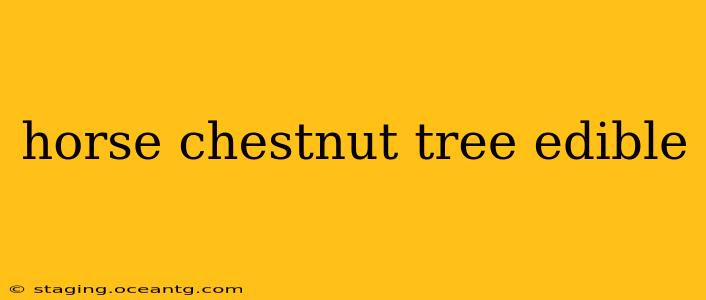The question of whether horse chestnut trees are edible is a crucial one, and the short answer is a resounding no. While the name might suggest otherwise, horse chestnuts ( Aesculus hippocastanum) are toxic to humans and should never be consumed. This article will delve deeper into the reasons behind this toxicity, address common misconceptions, and explore the important distinction between horse chestnuts and other edible nuts.
What Parts of the Horse Chestnut Tree Are Toxic?
All parts of the horse chestnut tree—the seeds (the conkers), the bark, the leaves, and the flowers—contain saponins, specifically aesculin and esculin. These compounds are bitter-tasting and can cause gastrointestinal upset, nausea, vomiting, and in severe cases, more serious health problems. Even touching the leaves or flowers can cause skin irritation in some individuals.
Can Horses Eat Horse Chestnuts?
The name "horse chestnut" is somewhat misleading. While horses might occasionally nibble on them, they are not a suitable food source for horses either. Large quantities of horse chestnuts can cause significant digestive issues in horses, and the toxicity risk remains. It's best to keep horses away from these trees entirely.
What About the "Sweet Chestnuts"? Are They Different?
This is a critical distinction to understand. Sweet chestnuts (Castanea sativa) are entirely different from horse chestnuts. They are a delicious and nutritious food source, widely enjoyed roasted, boiled, or used in various culinary applications. Sweet chestnuts are much smaller, have a pointed end, and grow on trees with smoother bark and differently shaped leaves than horse chestnut trees. The key is to learn to visually differentiate these two trees and their nuts.
Are There Any Edible Uses for Horse Chestnuts?
While the seeds, leaves, bark and flowers of the horse chestnut tree are toxic and shouldn't be ingested, historically, extracts from horse chestnuts have been used in folk medicine for various purposes. However, it's crucial to remember that these uses should not be considered a substitute for medical advice. Modern medicine does not endorse the use of horse chestnuts for medicinal purposes unless prescribed by a qualified healthcare professional who will likely use commercially prepared extracts, ensuring standardized dosage and purity. Self-treating with horse chestnuts can be dangerous.
What Happens if You Eat a Horse Chestnut?
Consuming even a small amount of horse chestnut can lead to symptoms such as nausea, vomiting, diarrhea, and abdominal pain. In more severe cases, it can cause weakness, tremors, and even paralysis in serious cases. If you suspect someone has ingested a horse chestnut, seek immediate medical attention.
How Can I Tell the Difference Between Horse Chestnuts and Sweet Chestnuts?
The easiest way to distinguish between horse chestnuts and sweet chestnuts is by examining the nuts and the trees themselves.
- Horse Chestnuts: Larger, rounder, with a fuzzy surface, and contain a large, dark brown seed. The trees have larger, palmate leaves.
- Sweet Chestnuts: Smaller, pointier, and have a smooth, brown shell. They contain multiple smaller seeds. The trees have thinner, lanceolate leaves.
Always visually identify the tree and its fruit before considering consumption of any nut.
Conclusion
Horse chestnut trees are beautiful and visually appealing, offering seasonal color and interest. However, it’s vital to remember that their nuts and other parts are toxic and should never be consumed. Confusing horse chestnuts with sweet chestnuts is a common mistake, so accurate identification is paramount. If you have any doubts, it's always best to err on the side of caution and avoid ingestion. If you or someone you know has ingested horse chestnuts, seek immediate medical attention.
